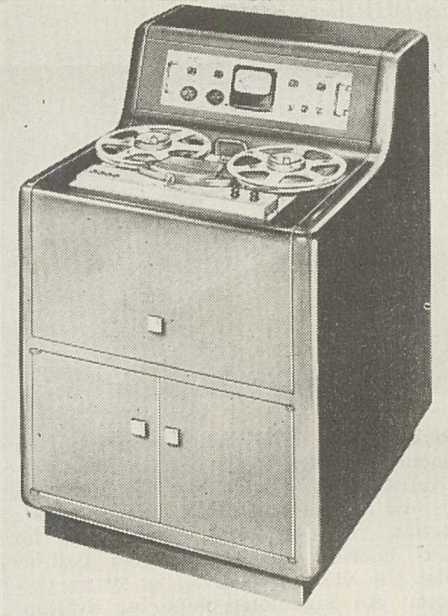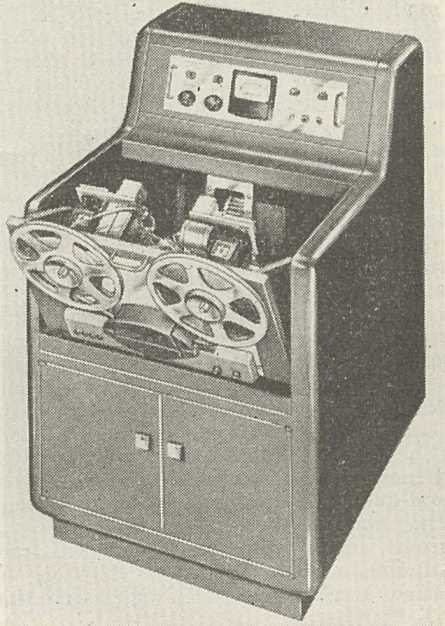Manufactured in Australia by Byer Industries
The following article is from the "NEWS AND NOTES" section of The Proceedings of the IRE Australia, March 1955. So far this is the only information I have found for this Magnecord model and Allan Rowlands an ex-employee of Byer Industries has confirmed that this was one of the Magnecord machines made for the Australian market by Byer.
NEW PROFESSIONAL TAPE RECORDER
|
The production in Australia of a new Professional Tape Recorder by Magnecord, (A/sia) Pty. Ltd., is announced. The makers claim that this machine, the M.80, has been designed to contain all the desirable operation features in addition to high performance standards. The first units were scheduled for delivery in November. It consists of two major units, the tape transport and the record-reproduce amplifier unit which includes the high-frequency oscillator. Both major assemblies may be mounted in a console as shown, in a portable carrying case which is furnished, or in a standard 19-inch relay rack. The complete tape transport is constructed on a standard 19-inch rack mounting panel. The panel is 12½ inches high and the mechanism extends 8 inches behind the panel. |

|

|
In this recorder certain features have been included in the panel layout. These are a constant speed capstan and pressure roller assembly, a tape tensioning or hold-back device, a take-up system to spool the tape after it passes the capstan, erase, record, and reproduce heads, compliance arms, and an interia-stabilizing roller to filter out tape speed irregularities produced as the tape leaves the pay-off reel. The layout of these components not only governs the performance of the unit to a great extent, but also affects the simplicity of operation. The tape path is straightforward and free of loops and curves around guide rollers. A three-position function control lever is included. Its positions are marked OPERATE, LOAD, and EDIT. When the lever is placed in the LOAD position the compliance arms, tape guide, and head covers are put in such a position that "straight-line" or "slot" loading of the tape is permitted. This feature eliminates most of the inconvenience normally encountered in tape threading. The head covers are open wide in the LOAD position for ease of head inspection and marking of tape. |
After the machine has been loaded with tape, the control lever is placed in the OPERATE position. This brings the compliance arms and head cover back into their normal positions. In the OPERATE position, the tape does not come into contact with the heads except during normal forward operation. This allows the tape to be run at high speed forward or rewind without excessive wear on the heads. When the tape is moving in the normal forward direction, as for playback or record, the tape guide and head cover are solenoid-actuated to cause the tape to engage the heads.
When the control knob is placed in the EDIT position the pushbutton switches are locked out of the circuit, and the tape is held against the heads. If one reel hub is then grasped in each hand the tape may be moved back and forth across the heads, permitting easy and rapid cueing.
In addition to the function control lever, other controls located in the front panel include four pushbutton switches labeled REWIND, STOP, FORWARD, HI FWD (high speed forward). Two rotary switches are located on the lower right hand side of the panel, one of which controls the tape speed, 7.5 or 15 inches per second. The other rotary switch turns the recorder mechanism on and off.
A record warning indicator light is provided on the transport unit panel which tells the operator when the unit is ready to record. This indicator light is lit when the record-playback switch (located on the front panel of the amplifier) is in RECORD position.
The tape is pulled by a direct-drive assembly consisting of a 600 / 1200 r.p.m. hysteresis synchronous motor with an integral ground capstan. A flywheel is mounted on the rear shaft extension of the motor.
During normal forward operation a reverse torque is applied to the pay-off motor, which maintains a relatively constant tape tension while the tape is being unwound from the pay-off reel. Slightly greater torque is applied to the take-up motor to provide sufficient torque to spool the tape.
The record head is a new unit developed specifically for this recorder. Its impedance is approximately 50 ohms at 1000 cps. Precision lapping such as that used in optical work has been employed to assure a very straight and uniform gap. Since recording is done with the trailing edge of the gap, the straightness of the gap edges is more important than the gap width itself. The record head gap length is in the order of .0007 to .001 inch. The reason for this large gap is to reduce the noise recorded on the tape due to residual localized d.c. magnetizations. of very small magnitude.
An input selector switch provides of feeding the amplifier unit from a high impedance balanced or unbalanced bridge input or a 50-ohm microphone. The VU meter function switch has three positions, record level, playback level, and bias measurement. The record playback switch includes a REMOTE position allowing the record or playback function to be controlled from a remote location. A monitor jack is provided on the front panel to provide monitoring directly from the programme source or from the tape. The monitoring voltage is switched simultaneously with the VU meter. An equalizer switch suits equalization to 7½ or 15-inch-per-second tape speed.
Performance figures claimed by the manufacturers include: Starting time for the tape less than 0.1 second and stopping takes place within 2 inches of tape when using the operating speeds. Flutter and wow are under 0.1 per cent r.m.s. at 15 i.p.s. and less than 0.15 per cent at 7.5 i.p.s. The signal to noise ratio is better than 58 db, based on a level giving a maximum of 3 per cent harmonic distortion.
Frequency response at 7½ i.p.s. within 4 db from 30 to 15,000 c.p.s. and within 2 db at 15 i.p.s.
